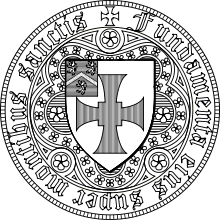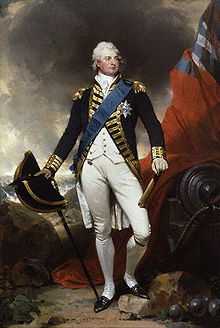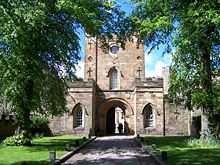History of Durham University

The history of The University of Durham spans over 180 years since it was founded by Act of Parliament on 4 July 1832 when the Act received Royal Assent from King William IV. The University of Durham was then subsequently granted a Royal Charter confirming its constitution by King William IV[1] on 1 June 1837. While this did not include explicit degree awarding powers, it stated that the fundamental statute passed by the Dean and Chapter (as governors of the University) on 20 July 1835 was "by virtue, and in pursuance of the trusts and powers in the said Act of Parliament, and of every other power enabling them in that behalf".[2] These 1835 statutes explicitly allowed the University to grant degrees, included a clause stating "that the degrees in the various faculties shall be conferred by the Warden in Convocation".[3] Durham University owns a 227.8 hectare (ha) estate[4] which includes a UNESCO world heritage site,[5] one ancient monument,[4] five grade-one listed buildings[4] and 68 grade two-listed buildings[4] along with 44.9 ha of woodland.[4] The estate is divided into two campuses: Durham City and Queens Campus, Stockton.
Origins

The strong tradition of theological teaching in Durham gave rise to various attempts to form a university there, notably under King Henry VIII and Oliver Cromwell, who issued letters patent and nominated a proctor and fellows for the establishment of a college in 1657.[8] However, there was deep concern expressed by Oxford and Cambridge that the awarding of degree powers could hinder their position.[1] Consequently, it was not until 1832 when Parliament, at the instigation of Archdeacon Charles Thorp and with the support of the Bishop of Durham, William van Mildert, passed "an Act to enable the Dean and Chapter of Durham to appropriate part of the property of their church to the establishment of a University in connection therewith" to fund a new university, that the University actually came into being. Accommodation was provided in the Archdeacon's Inn from 1833 to 1837 when an order of the Queen-in-Council was issued granting the use of Durham Castle, previously a palace of the Palatinate See, as a college of the university.[1] The Act received Royal Assent and became law on 4 July 1832. The University's Royal Charter was granted on 1 June 1837 by William IV, with the first students graduating a week later on 8 June 1837.[1]
19th century
In 1846, Bishop Hatfield's Hall (later to become Hatfield College) was founded, providing for the opportunity for students to obtain affordable lodgings with fully catered communal eating. Those attending University College were expected to bring a servant with them to deal with cooking, cleaning and so on. Elsewhere, the University expanded from Durham into Newcastle in 1852 when the medical school there (established in 1834) became a college of the University.[1] This was joined in 1871 by the College of Physical Sciences (renamed the College of Science in 1884 and again renamed Armstrong College in 1904). St Cuthbert's Society was founded in 1888 to cater for non-resident students in Durham (although now mainly caters for resident students), while two teacher-training colleges—St Hild's for women, established in 1858, and The College of the Venerable Bede for men, established in 1839,[1] also existed in the city. These merged to form a mixed college (the College of St Hild and St Bede) in 1975. From 1896 these were associated with the University and graduates of St Hild were the first female graduates from Durham in 1898.
In 1842 the Durham Union Society was set up as a forum for debates, the first of which took place in the reading rooms in Hatfield Hall. It also served as the students' union (hence the name) until Durham Colleges Students' Representative Council was founded in 1899, thus separating into two independent bodies, the DSU and DUS (it was later renamed Durham Students' Union in 1963).
For most of the 19th century, University of Durham degrees were subject to a religion test and could only be taken by members of the established church. This situation lasted until the Universities Tests Act 1871. However, "dissenters" were able to attend Durham and then receive degrees of the University of London, which were not subject to any religious test, on completing their course. Following the grant of a supplemental charter in 1895 allowing women to receive degrees of the University, the Women's Hostel (St Mary's College from 1919) was founded in 1899.
Female students at Durham University
Women have been admitted to Durham since the 1890s. In 1895 Senate petitioned the Crown for a supplementary charter enabling degrees to be conferred on women and in the Michaelmas Term, 1896, the first four women students matriculated, all of them members of St. Hild's College. In 1899 Abbey House on Palace Green was opened as a Women's Hostel. By resolution of the Council of the Durham Colleges in 1919, the Women's Hostel became known as St. Mary's College. Women students residing at home had first been admitted in 1895 and in 1947 this body of women students became known as St. Aidan's Society, with its own Principal. It became St. Aidan's College in 1961. From 1990, with the exception of St. Mary's College (which remained as a college for women until 2005) and Ushaw College, which is for men only, all the Colleges and Societies were open to both men and women.
20th century

The Newcastle division of the University, in particular Armstrong College, quickly grew to outnumber the Durham colleges, despite the addition of two Anglican foundations: St Chad's College (1904) and St John's College (1909). A parliamentary bill proposed in 1907 would have fixed the seat of the University in Durham for only ten years, allowing the Senate to choose to move to Newcastle after this. This was blocked by a local MP, with the support of graduates of the Durham colleges, until the bill was modified to establish a federal university with its seat fixed in Durham. This reform also removed the University from the authority of the Dean and Chapter of Durham Cathedral, who had nominally been in charge of the University since its foundation. Thirty years after this, the Royal Commission of 1937 recommended changes in the constitution of the federal University, resulting in the merger of the two Newcastle colleges to form King's College. The Vice-Chancellorship alternated between the Warden of the Durham Colleges and the Rector of King's. (The legacy of this lives on, in that the titular head of the University is still called "The Vice-Chancellor and Warden.")
After the Second World War, the Durham division expanded rapidly. St Aidan's Society (St Aidan's College from 1965) was founded in 1947 to cater for non-resident women and the decision was made to expand onto Elvet Hill, vastly expanding the existing pure science provision in Durham, and adding applied science and engineering.
In 1947, the foundation stones for the new St. Mary's College building on Elvet Hill were laid by Princess Elizabeth (later Queen Elizabeth II). The new building opened in 1952, and is said to be the last government funded university building to have been built in stone. In the same year, tensions surfaced again over the Durham-Newcastle divide, with a proposal to change the name of the University to the 'University of Durham and Newcastle' (or as some wag put it 'the University of Durham and Newcastle United'). This motion was defeated in Convocation (the assembly of members of the University) by 135 votes to 129. Eleven years later, with the Universities of Durham and Newcastle upon Tyne Act 1963, King's College became the University of Newcastle upon Tyne, leaving Durham University based solely in its home city.
By this time, the Elvet Hill site was well established, with the first of the new colleges, Grey College (named after the second Earl Grey, who was the Prime Minister when the University was founded) being founded in 1959. Expansion up Elvet Hill continued, with Van Mildert College and the Durham Business School (1965), Trevelyan College (1966) and Collingwood College (1972) all being added to the University, along with a botanic garden (1970).
These were not the only developments in the University, however. The Graduate Society, catering for postgraduate students, was founded in 1965 (renamed Ustinov College in 2003) and the Roman Catholic seminary of Ushaw College, which had been in Durham since 1808, was licensed as a hall of residence in 1968. By 1990, the last male-only college became mixed, leaving St Mary's as the last single-sex college.
Queen's Campus, Stockton
In 1992, a joint venture between the University and the University of Teesside saw the Joint University College on Teesside of the Universities of Durham and Teesside (JUCOT) established at Thornaby-on-Tees in the borough of Stockton-on-Tees, 25 miles (40 km) to the south of Durham. This was initially intended to grant joint degrees validated by both institutions (BAs and BScs). However, Teesside, which had only become a university in 1992, had difficulties in taking on its responsibilities for the college and Durham took full control of the new college in 1994.
A programme of integration with Durham began, leading to the college becoming University College, Stockton (UCS) in 1996—a college of the University of Durham. Further integration led to the campus being renamed the University of Durham, Stockton Campus (UDSC) in 1998, removing teaching responsibilities from the College. In 2001, two new colleges, John Snow and George Stephenson (after the physician and the engineer) were established at Stockton, replacing UCS, and the new medical school (which operates in association with the University of Newcastle upon Tyne) took in its first students — the first medics to join Durham since 1963. In 2002, her golden jubilee year, the Queen granted the title "Queen's Campus" to the Stockton site.
As of 2005 Queen's Campus, Stockton accounts for around 18% of the total university student population.[9] This is likely to increase in coming years thanks to future expansion plans.In 2007 the campus cafeteria, "The Waterside Room", was renovated and now serves as the campus student bar. In contrast to Durham college bars, it is run by the University and not a JCR or DSU.
A curious fact about Queen's Campus, Stockton, is that it is located on the south bank of the River Tees within Thornaby-on-Tees and not in Stockton at all. For centuries the Tees formed the historical division between the historic counties of Yorkshire and Durham, with Thornaby-on-Tees being one of the most northern towns in Yorkshire. With the creation of the county borough of Teesside in 1968 areas both north and south of the river were removed from their administrative counties. Teesside itself was engulfed into the County of Cleveland in 1974. Yet another local government change in 1996 saw the breakup of the county of Cleveland into the current four unitary authorities of Middlesbrough, Hartlepool, Redcar and Cleveland & Stockton-on-Tees. With this latest reorganisation Thornaby-On-Tees became part of the borough of Stockton-on-Tees, however the town of Stockton-on-Tees itself is located on the north ("County Durham") side of the river, and is one of the most southerly towns Durham. The upshot of all this is that a significant proportion of Durham University is actually located within the ceremonial county of North Yorkshire, rather than County Durham. Adding to the confusion, plans exist to expand the campus on to the north bank of the River Tees, splitting the campus between the two ceremonial counties.
Recent developments
In 2005, the University unveiled a re-branded logotype and renamed itself as "Durham University". The news was poorly received among many academic and student members of the university, with Van Mildert JCR going as far as boycotting the new name and logo.[10] However, the official name of the institution remains the University of Durham and the official coat of arms is unchanged.
In the last half of the 20th century, the number of students at the university has grown considerably, and continues to grow with the addition of Queen's Campus, Stockton. The more recent rises are in line with government policy of increasing access to higher education. In 1989 the University started its fund-raising and alumni office, with a virtual community for alumni[11] and several large gifts made to the University, including for the Centre for Middle Eastern Studies, the Department of Physics and the Wolfson Research Institute. In 2006 Josephine Butler College, opened at the Howlands Farm site on Elvet Hill. This was the first new college to open in Durham itself since the 1970s, at the creation of Collingwood. The University's Strategic Plan through to 2010 is at the University's web site.[12] In 2005, St. Mary's College had its first mixed undergraduate intake. In October 2006, Josephine Butler College, a long-standing development, opened its doors to students as Durham's newest college; the only purpose-built self-catering college for students within Durham.
In July 2009 the former British Prime Minister Tony Blair announced a strategic partnership with Durham University, following Yale University and National University of Singapore, to create a global network of twelve leading research universities for delivering his Faith and Globalization Initiative in association with Tony Blair Faith Foundation.[13]
References
- ↑ 1.0 1.1 1.2 1.3 1.4 1.5 http://www.dur.ac.uk/resources/university.calendar/volumei/2009.2010/historical_note.pdf
- ↑ "About Durham University: Royal Charter". Durham University. Retrieved 2014-12-24.
- ↑ J. T. Fowler. Durham university; earlier foundations and present colleges. F. E. Robinson & co., 1904. Retrieved 2014-12-24.
- ↑ 4.0 4.1 4.2 4.3 4.4 "University of Durham Framework and Masterplan" (PDF). Durham University. Retrieved 2009-01-11.
- ↑ "Durham's World Heritage Site expands". Durham University. Retrieved 2009-01-11.
- ↑ Castle JCR
- ↑ "Widening access without diluting quality". The Times (London). 2005-10-02. Retrieved 2010-05-04.
- ↑ The Penny Cyclopædia of the Society for the Diffusion of Useful Knowledge. C. Knight, 1838. Retrieved 2009-05-31.
- ↑ The University : Student Statistics - Durham University
- ↑ Van Mildert College JCR Minutes http://www.dur.ac.uk/vm.jcr/dl.php?file=minutes-2005-05-08.pdf Retrieved on 5 March 2007
- ↑ http://www.dunelm.org.uk dunelm.org.uk
- ↑ The University : Strategy 2005-10 - Durham University
- ↑ http://www.tonyblairfaithfoundation.org/2009/07/parnership-with-durham-univers.html
External links
| Wikimedia Commons has media related to University of Durham. |
| |||||||||||||||||||||||||||||||||

